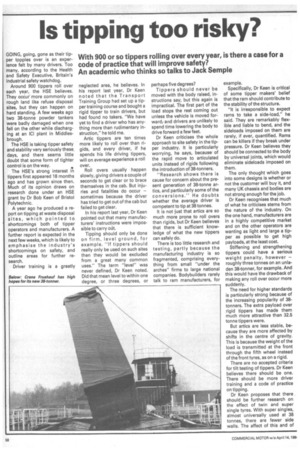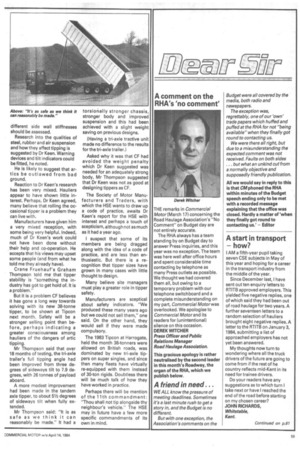Is tipping too risky?
Page 60

Page 61

If you've noticed an error in this article please click here to report it so we can fix it.
With 900 or so tippers rolling over every year, is there a case for a code of practice that will improve safety?
An academic who thinks so talks to Jack Semple
GOING, going, gone as their tipper topples over is an experience felt by many drivers. Too many, according to the Health and Safety Executive, Britain's industrial safety watchdog.
Around 900 tippers roll over each year, the HSE believes. They occur more commonly on rough land like refuse disposal sites, but they can happen on hard standing. A few weeks ago two 38-tonne powder tankers were badly damaged when one fell on the other while discharging at an ICI plant in Middlesbrough.
The HSE is taking tipper safety and stability very seriously these. days, and there seems little doubt that some form of tighter control is on the way.
The HSE's strong interest in tippers first appeared 18 months ago and has grown since then. Much of its opinion draws on research done under an HSE grant by Dr Bob Keen of Bristol Polytechnic.
A year ago he produced a report on tipping at waste disposal sites, which pointed to shortcomings both of tipper operators and manufacturers. A further report is expected in the next few weeks, which is likely to emphasise the industry's shortcomings on safety, and outline areas for further research.
Driver training is a greatly neglected area, he believes. In his report last year, Dr Keen noted that the Transport Training Group had set up a tipper training course and bought a rigid tipper to train drivers, but had found no takers. "We have yet to find a driver who has anything more than rudimentary instruction," he told me.
Artic tippers are ten times more likely to roll over than rigids, and every driver, if he spends his life driving tippers, will on average experience a roll over.
Roll overs usually happen slowly, giving drivers a couple of seconds to get clear or to brace themselves in the cab. But injuries and fatalities do occur — sometimes because the driver has tried to get out of the cab but failed to get clear.
In his report last year, Dr Keen pointed out that many manufacturers' instructions were impossible to carry out.
Tipping should only be done on firm, level ground, for example. "If tippers should really only be used on such sites then they would be excluded from a great many common uses." The term "level" •was never defined, Dr Keen noted. Did that mean level to within one degree, or three degrees, or perhaps five degrees?
Tippers should never be moved with the body raised, instructions say, but this again is impractical. The first part of the load stops the rest coming out unless the vehicle is moved forward; and drivers are unlikely to spend time lowering the body to drive forward a few feet.
Dr Keen criticises the whole approach to site safety in the tipper industry. It is particularly worrying, he says, because of the rapid move to articulated units instead of rigids following the introduction of 38-tonners.
"Research shows there is cause for concern about the present generation of 38-tonne artics, and particularly some of the conversions." He doubts whether the average driver is competent to tip at 38 tonnes.
It is not just that artics are so much more prone to roll overs than rigids, but Dr Keen believes that there is sufficient knowledge of what the new tippers can safely do.
There is too little research and testing, partly because the manufacturing industry is so fragmented, comprising everything from small "under the arches" firms to large national companies. Bodybuilders rarely talk to ram manufacturers, for example.
Specifically, Dr Keen is critical of some tipper makers' belief that the ram should contribute to the stability of the structure.
"It is irresponsible to expect rams to take a side-load," he said. They are remarkably flexible and liable to bend, and the sideloads imposed on them are rarely, if ever, quantified. Rams can be killers if they break under pressure. Dr Keen believes they should be connected to the body by universal joints, which would eliminate sideloads imposed on them.
The only thought which goes into some designs is whether or not the customer will buy it, and many UK chassis and bodies are not strong enough for the job.
Dr Keen recognises that much of what he criticises stems from the nature of the industry. On the one hand, manufacturers are in a highly competitive market and on the other operators are wanting as light and large a tipper as possible to get high payloads, at the least cost.
Stiffening and strengthening tippers could have a serious weight penalty, however — roughly three tonnes on an unladen 38-tonner, for example. And this would have the drawback of making any roll over occur more suddenly.
The need for higher standards is particularly strong because of the increasing popularity of 38tanners. The extra payload over rigid tippers has made them much more attractive than 32.5 tonne tippers were.
But artics are less stable, because they are more affected by shifts in the centre of gravity. This is because the weight of the load is transmitted at the front through the fifth wheel instead of the front tyres, as on a rigid.
There are no accepted criteria for tilt testing of tippers. Dr Keen believes there should be one. There should be more driver training and a code of practice on tipping.
Dr Keen proposes that there should be further research on the effect of twin and super single tyres. With super singles, almost universally used at 38 tonnes, there are fewer side walls. The affect of this and of different side wall stiffnesses should be assessed.
Research into the qualities of steel, rubber and air suspension and how they affect tipping is suggested by Dr Keen. Warning devices and tilt indicators could befitted, he noted.
He is likely to suggest that artics be outlawed from bad ground.
Reaction to Dr Keen's research has been very mixed. Hauliers appear to have shown little interest. Perhaps, Dr Keen agreed, many believe that rolling the occasional tipper is a problem they can live with.
Manufacturers have given him a very mixed reception, with some being very helpful. Indeed, much of Dr Keen's work could not have been done without their help and co-operation. He accepts that his views may upset some people (and from what he told me they already have).
Crane Fruehauf's Graham Thompson told me that tipper stability is "something the industry has got to get hold of. It is a problem."
But it is a problem CF believes it has gone a long way towards solving with its new 38-tonne tipper, to be shown at Tipcon next month. Safety will be a stronger selling point than before, perhaps indicating a greater consciousness among hauliers of the dangers of artic tipping.
Mr Thompson said that over. 18 months of testing, the tri-axle trailer's full tipping angle had been improved from three degrees of sideways tilt to 7.9 degrees, with 26 tonnes of payload aboard.
A more modest improvement had been made in the tandem axle tipper, to about 51/2 degrees of sideways tilt when fully extended.
Mr Thompson said: "It is as safe as we think it can reasonably be made." It had a torsionally stronger chassis, stronger body and improved suspension and this had been achieved with a slight weight saving on previous designs.
(Having a tri-axle tractive unit made no difference to the results for the tri-axle trailer.) Asked why it was that CF had avoided the weight penalty which Dr Keen suggested was needed for an adequately strong body, Mr Thompson suggested that Dr Keen was not as good at designing tippers as CF.
The Society of Motor Manufacturers and Traders, with which the HSE wants to draw up a code of practice, awaits Dr Keen's report for the HSE with interest and perhaps a touch of scepticism, although not as much as it had a year ago.
I suspect that some of its members are being dragged along with the idea of a code of practice, and are less than enthusiastic. But there is a recognition that tipper sizes have grown in many cases with little thought to design.
Many believe site managers must play a greater role in tipper safety.
Manufacturers are sceptical about safety indicators. "We produced these many years ago but we could not sell them," one said. On the other hand, they would sell if they were made compulsory.
The 1983 Tipcon at Harrogate, held the month 38-tonners were allowed on British roads, was dominated by new tri-axle tippers on super singles, and since then many fleets have virtually re-equipped with them instead of 30-ton rigids. Doubtless there will be much talk of how they have worked in practice.
Perhaps there will be mention of the 11th commandment: "Thou shall not tip alongside thy neighbour's vehicle." The HSE may in future have a few more specific commandments of its own in mind.




























































































